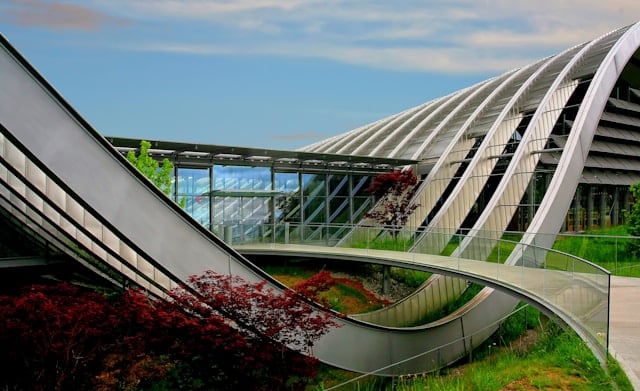How to Use Landscape Architecture to Improve Urban Air Quality?

As urban centres continue to grow, the need for innovative approaches to mitigate the negative effects of urbanisation becomes evident. One of the severe consequences of city expansion is air pollution, a problem that poses serious health risks to city dwellers. How, then, can we counter this situation? The answer may lie in a seemingly unrelated field – landscape architecture.
Landscape architecture, a discipline dedicated to the design and planning of outdoor spaces, can offer creative and sustainable solutions to improve air quality in urban areas. This article delves into an examination of how landscape architecture can contribute to cleaner air in our cities.
A lire aussi : How Can Real Estate Developers Contribute to Local Economies Through Strategic Project Planning?
The Green Resolution
The first step is to identify the indispensable role that green infrastructure plays in combating air pollution. Green infrastructure refers to a network of spaces and landscape features that provide environmental and quality-of-life benefits to urban residents. Such infrastructure can include parks, green roofs, community gardens, and tree-lined streets.
Green infrastructure not only adds aesthetic value to urban areas but also plays a crucial role in purifying the air. Through the process of photosynthesis, plants absorb carbon dioxide and other pollutants, releasing oxygen in return. In this way, green infrastructure acts as a natural filter, improving the air quality and creating healthier, more livable urban environments.
A voir aussi : What Design Principles Should Be Considered to Maximize Daylight in Urban Dwellings?
The Power of Design in Air Quality Improvement
Design is a powerful tool in the hands of landscape architects; it can shape spaces, guide human behaviour and influence environmental processes. A well-thought-out design can integrate green infrastructure into the urban fabric, making it more accessible and effective.
In tackling air pollution, the strategic placement of green spaces is key. For instance, trees and plants can be used as buffers along busy roads or around industrial areas, absorbing pollutants and mitigating their impact. Furthermore, green roofs and walls can be incorporated into buildings, offering additional air-filtering surfaces and reducing the heat-island effect.
Understanding the local climate and wind patterns can also inform design decisions. For example, in areas with prevailing winds, green spaces can be designed and located such that they channel clean air towards densely populated areas.
Engaging the Community
The success of any urban initiative greatly depends on community engagement. Encouraging residents to participate in the creation and maintenance of green spaces not only nurtures a sense of ownership but also results in spaces that better respond to the community’s needs.
Involving the community in the planning process allows for the exchange of local knowledge, which can enrich the design. Also, community-based initiatives can promote environmentally friendly practices, such as gardening without pesticides, which can further enhance air quality.
Moreover, green spaces can serve as venues for social interaction and physical activity, contributing to the overall well-being of the community. Thus, the positive effects of landscape architecture extend beyond environmental benefits, fostering social cohesion and active lifestyles.
ASLA and the Pursuit of Cleaner Air
The American Society of Landscape Architects (ASLA) recognizes the importance of landscape architecture in improving urban air quality. The ASLA provides guidelines and resources to guide landscape architects in designing green infrastructure that mitigates air pollution.
Additionally, the ASLA advocates for policies that support the implementation of green infrastructure in urban areas. It also encourages research to further understand the role of landscape architecture in air quality improvement and to develop new methods and strategies.
The Role Model: Green Urbanism in China
China’s rapid urbanisation has resulted in severe air pollution problems. However, the country is making strides in tackling this issue through landscape architecture. Among the innovative solutions is the concept of "Forest City", a city where every building is covered in plants and trees.
Designed by Stefano Boeri Architetti, the Forest City in Liuzhou, China, aims to absorb nearly 10,000 tons of CO2 and 57 tons of pollutants yearly while producing approximately 900 tons of oxygen. This ambitious project embodies the potential of landscape architecture in mitigating air pollution and offers an inspiring model for cities worldwide.
In conclusion, landscape architecture represents a powerful tool for addressing air pollution in urban areas. Through creative design, community engagement, and a diligent pursuit of greener urbanism, we can create cities that are not only beautiful but also healthy and sustainable. While the task may seem daunting, the rewards—cleaner air, healthier communities, and enhanced overall quality of life—are well worth the effort.
Green Infrastructure and Community Health
When discussing the benefits of green infrastructure, it’s important not to overlook its impact on community health. The reduction in air pollution that results from the increased presence of green spaces tends to lead to an overall healthier population. Studies have shown a correlation between exposure to green spaces and a decrease in stress, improved mental health, and increased physical activity.
Efforts to improve air quality through landscape architecture aren’t solely focused on a long-term reduction in air pollution. They also provide immediate health benefits to the surrounding community. By offering a visually pleasing environment, green spaces help to reduce stress and promote relaxation.
Exposure to nature has been shown to stimulate the parasympathetic nervous system, which helps to restore our bodies to a calm and relaxed state. This makes green spaces a valuable tool in combating the chronic stress often associated with urban living.
Additionally, green spaces such as parks and community gardens encourage physical activity, which is essential to overall health. Regular exercise can help to prevent various health issues such as obesity, diabetes, and heart disease.
Moreover, green roofs and walls, besides being innovative solutions to air pollution, can also mitigate the heat-island effect. This refers to the phenomenon where urban areas are significantly warmer than their rural surroundings due to human activities, leading to increased energy consumption and heat-related illnesses.
By investing in green infrastructure, cities can create healthier environments for their residents, reinforcing the importance of landscape architecture in urban planning.
Conclusion: The Future of Urban Air Quality
In the face of growing urbanisation and the accompanying air quality challenges, landscape architecture offers a fresh and sustainable approach. The implementation of green infrastructure can significantly improve urban air quality, resulting in healthier, more liveable cities.
Green spaces, be they parks, green roofs, or tree-lined streets, act as the lungs of a city, absorbing harmful pollutants and releasing clean oxygen. The strategic placement and design of these spaces can enhance their efficiency and accessibility, maximising their impact on air quality.
Moreover, the engagement of the community in the planning and maintenance of these spaces cultivates a sense of ownership and responsibility, promoting environmentally friendly practices. It also fosters social cohesion and encourages physical activity, contributing to the overall well-being of the community.
The American Society of Landscape Architects and other such organisations are at the forefront of these efforts, advocating for policies that support green infrastructure and conducting research to develop new strategies.
Furthermore, inspiring models like the Forest City in China demonstrate the immense potential of landscape architecture in tackling air pollution. These projects show that with creativity and commitment, it is possible to design cities that are not only visually appealing but also sustainable and healthy.
In sum, we must celebrate the insightful contribution of landscape architecture in improving air quality and support its wider implementation. It’s not just about making our cities greener – it’s about making them healthier and more sustainable for generations to come. Let’s love, support, and encourage this longer contribution and continue to report on the positive effects it brings to our urban landscapes.
